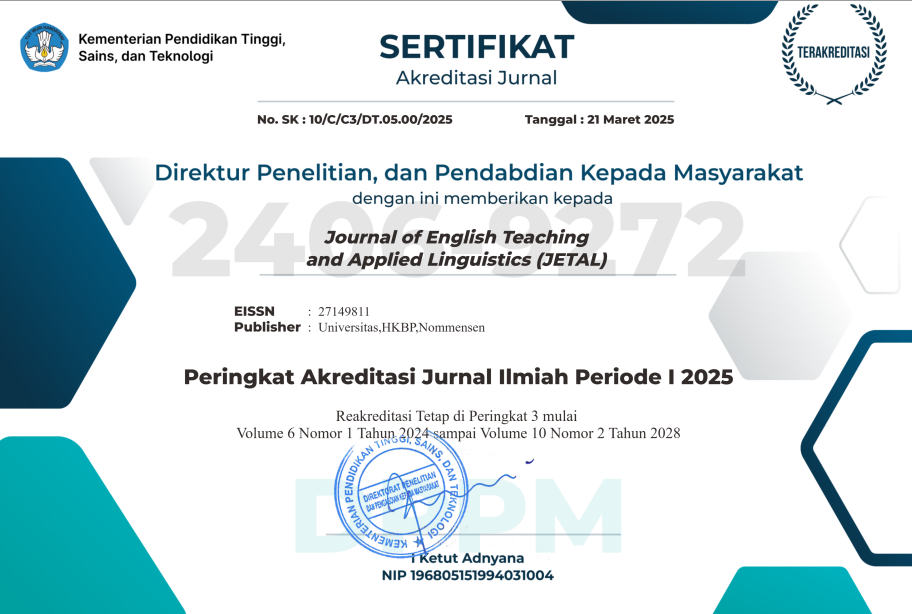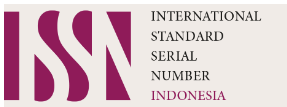The Impact of Social Media and 4C Skills (Critical Thinking, Communication, Creativity, Collaboration) in English Language Learning: Students’ voices
Abstract
This study explores students’ subjective perspectives on the use of social media platforms (e.g., TikTok, Instagram, YouTube) in developing their 21st-century 4C skills (Critical Thinking, Communication, Creativity, Collaboration) within an English Language Learning (ELL) context. Using descriptive qualitative methods with semi-structured interviews, this study synthesizes wide-ranging perceptions on the use of platforms and how they facilitate students in improving 4C skills in English learning. The results were further analyzed thematically. Key findings indicate that, although students recognized that social media is an accessible and engaging tool for English learning, its use for developing 4C skills is not without significant challenges. Students posited that social media effectively facilitates the practice of communication skills (writing and speaking), stimulates creativity, and supports online collaboration skills. However, they also suggested that the development of critical thinking is hampered by the difficulties in evaluating the credibility of information online. The practical implications of this study highlight the need for lecturers to design structured pedagogical support and for policymakers to integrate digital literacy into the curriculum. Without strategic guidance, the potential of social media to enhance 4C skills is at risk of being underutilized.
References
Abedi, S. R., Elahi, S., Abedi, S. R., & Elahi, S. (2023). Leveraging Social Media Platforms to Enhance Students ’ English Proficiency : A Comprehensive Analysis Leveraging Social Media Platforms to Enhance Students ’ English Proficiency : A Comprehensive Analysis. December.
Al-rahmi, W. M., Alias, N., Othman, M. S., Alzahrani, A. I., Alfarraj, O., Saged, A. L. I. A. L. I., Shamsiah, N. U. R., & Rahman, A. (2018). Use of E-Learning by University Students in Malaysian Higher Educational Institutions : A Case in Universiti Teknologi Malaysia. IEEE Access, 6, 14268–14276. https://doi.org/10.1109/ACCESS.2018.2802325
Annisa, P., Gultom, F., & Debora, M. (2024). The Implementation of 4c Skills (Creative Thinking, Critical Thinking and Problem Solving, Communication & Collaboration) in Learning Contextual Oral Language Skills. https://doi.org/10.4108/eai.24-10-2023.2342058
Ascencio, M. B. (2022). Discussion and Guidelines About Using Tiktok To Stimulate Creativity in the Classroom. https://www.theseus.fi/bitstream/handle/10024/754304/Bazan_Monica.pdf?sequence=2
Br Batubara, K., Helena Natalia, C., & Khairina, Y. (2024). TALENTA Conference Series: Local Wisdom, Social, and Arts Designing Innovative Learning Media for Speaking Skill based on the 4Cs (Critical Thinking, Communication, Collaboration, and Creativity) Designing Innovative Learning Media for Speaking Skill base. 7(2). https://doi.org/10.32734/lwsa.v7i2.2064
Braun, V., & Clarke, V. (2019). Thematic analysis revised. Journal of Chemical Information and Modeling, 53(9), 1689–1699.
Caramihai, M., Severin, I., & Chiș, D. (2023). Students ’ Perception About Online Social-Media in Higher Education : An Empirical Study Opportunities of Employing Social. Isaic 2022, 292–298. https://doi.org/10.5220/0011922300003612
Cavell, A. J. (1954). A rapid method for the determination of nitrogen, phosphorus and potassium in plant materials. Journal of the Science of Food and Agriculture, 5(4), 195–200. https://doi.org/10.1002/jsfa.2740050407
Davis, F. D. (1989). Perceived usefulness, perceived ease of use, and user acceptance of information technology. MIS Quarterly: Management Information Systems, 13(3), 319–339. https://doi.org/10.2307/249008
Elaine, F., & Fuady, I. (2023). The Effectiveness Factors of Student Learning through TikTok Media with the Application of the TAM Model. Jurnal Pendidikan Multimedia (Edsence), 5(1), 01–10. https://doi.org/10.17509/edsence.v5i1.52882
Haque, M. Z. (2023). The Use of Social Media Platforms in Language Learning: A Critical Study. Journal of Global Research in Education and Social Science, 17(1), 20–28. https://doi.org/10.56557/jogress/2023/v17i18109
Karaca-Atik, A., Meeuwisse, M., Gorgievski, M., & Smeets, G. (2023). Uncovering important 21st-century skills for sustainable career development of social sciences graduates: A systematic review. Educational Research Review, 39(Cc). https://doi.org/10.1016/j.edurev.2023.100528
Machmud, K. (2014). Integrating Technology in EFL Curriculum: Determining EFL Teachers’ Level of Technology Literacy. TEFLIN International Conference, October 2014.
Mahmud, M., La Sunra, & Syariruddin Dollah. (2024). Authentic Projects in Teaching Listening: An Overview of Project-Based Learning (PBL) in Listening for Professional Contexts. INTERACTION: Jurnal Pendidikan Bahasa, 11(2), 603–617. https://doi.org/10.36232/interactionjournal.v11i2.501
Mackiewicz, J. (2018). A Mixed-Method Approach. In Writing Center Talk over Time. https://doi.org/10.4324/9780429469237-3
Marwa, M., Nurfaisal, N., Mualiardi, M., Awal, R., & Irawan, H. (2024). Enhancing 21st Century Skills in the EFL Classroom: Exploring Teachers’ Implementation of Group Activities and Assignments. AL-ISHLAH: Jurnal Pendidikan, 16(2), 1740–1756. https://doi.org/10.35445/alishlah.v16i2.5355
Mohd Hishamuddin, I. I. I., Mohamad Kamal, A. S., Abd. Rahman, S. F., Ahmad, N., & Drs Nasrul, M. A. (2023). Social Media in the Language Classrooms: Maximizing Students’ Higher Order Thinking Skills (HOTS). International Journal of Academic Research in Business and Social Sciences, 13(8), 691–699. https://doi.org/10.6007/ijarbss/v13-i8/17348
Monib, W. K. (2023). Implementation of 21st Century Skills in EFL Classroom: Perceptions of Lecturers and Students. International Journal on Social and Education Sciences, 5(3), 536–559. https://doi.org/10.46328/ijonses.544
Namaziandost, E., & Nasri, M. (2019). The Impact of Social Media on EFL Learners ’ Speaking Skill : A Survey Study Involving EFL Teachers and Students. January.
Penny. (2019). Framework for 21st century learning. Partnership for 21st Century Learning, 1–2. http://static.battelleforkids.org/documents/p21/P21_framework_0816_2pgs.pdf%0Ahttp://www.p21.org/our-work/p21-framework
Padurean, A. N., & Pădurean, A. N. (2025). Digitalization and Gamification in ELT . A Pathway to Successful Teaching Digitalization and Gamification in ELT ซ A Pathway. 0–8. https://doi.org/10.20944/preprints202501.1718.v1
Partono, P., Wardhani, H. N., Setyowati, N. I., Tsalitsa, A., & Putri, S. N. (2021). Strategi Meningkatkan Kompetensi 4C (Critical Thinking, Creativity, Communication, & Collaborative). Jurnal Penelitian Ilmu Pendidikan, 14(1), 41–52. https://doi.org/10.21831/jpipfip.v14i1.35810
Penyelenggara Jasa Internet Indonesia)APJII (Asosiasi. (2024). Internet Indonesia. Survei Penetrasi Internet Indonesia, 1–90. https://survei.apjii.or.id/survei/group/9
Ratih, K., & Fauziati, E. (2024). INNOVATIVE PEDAGOGIES : ENHANCING ELT / TESOL THROUGH. 5(2), 136–146.
Saini, N., & Mir, S. A. (2023). Social Media : Usage And The Impact On Education. 3, 4670–4689.
Sugiono. (2013). Metode Penelitian Kuantitatif, Kualitatif, dan R&D (Issue January).
Utari, R., Fitria, N., & Usman, M. (2023). The Students’ Perception of Instagram Accounts in Improving English Speaking Skills. English LAnguage Study and TEaching, 4(1), 19–27. https://doi.org/10.32672/elaste.v4i1.5821
Zainal, Z. (2020). European Journal of Education Studies Social Media And Its Influence On Vocabulary And Language Learning : A Case Study. 1–18. https://doi.org/10.46827/ejes.v7i11.3259

This work is licensed under a Creative Commons Attribution-ShareAlike 4.0 International License.
Authors retain copyright and grant the journal right of first publication with the work simultaneously licensed under a Creative Commons Attribution-ShareAlike 4.0 International License (CC BY-SA 4.0) that allows others to share the work with an acknowledgment of the work's authorship and initial publication in this journal.
Authors are able to enter into separate, additional contractual arrangements for the non-exclusive distribution of the journal's published version of the work (e.g., post it to an institutional repository or publish it in a book), with an acknowledgment of its initial publication in this journal.
Authors are permitted and encouraged to post their work online (e.g., in institutional repositories or on their website) prior to and during the submission process, as it can lead to productive exchanges, as well as earlier and greater citation of published work (See The Effect of Open Access).






